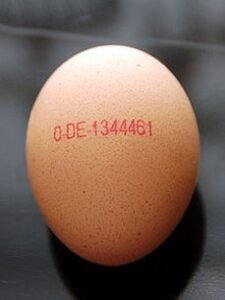Short Guide to Egg Labeling in EU
When you buy eggs in Europe, have you noticed the label, directly on the eggshell? Have you ever wondered what those labels on eggs mean? This ‘Short Guide to Egg Labeling in EU’ can help with the meaning of labels on Eggs in Germany and other European countries.
Egg labeling in the EU is an important part of the egg industry. The egg code stamped on the eggshell provides consumers with important information about the eggs they are purchasing, including the country of production, the producer, the production method, and the date of production. The EU has strict regulations regarding egg labeling, including the information that must be included on the label and the method used to stamp the egg code on the eggshell. By understanding the egg code and the husbandry system used to produce the eggs, consumers can make informed purchasing decisions. Let’s dive in!
Egg Labeling in the European Union (EU)
Egg labeling in the European Union (EU) is an essential part of the egg industry. The EU has strict regulations regarding egg labeling, including the information that must be included on the label and the method used to stamp the egg code on the eggshell. In this guide, we will describe what egg labeling is, explain the egg code that is stamped on the eggshell, describe the husbandry system used to produce the eggs, and cite the relevant EU laws.
What is Egg Labeling?
Egg labeling is the process of placing information about the eggs on the packaging. The information included on the label must be clear, accurate, and easy to understand. In the EU, egg labeling is regulated by the EU Food Information for Consumers Regulation No. 1169/2011.
Egg Code
In Europe, an egg code is stamped on the egg shell. The laws bring transparency to origin and method of production.
The Egg Code contains 3 sections:
- Husbandry system or method of production: Helps distinguish free range eggs and organic farming eggs, for example
- Country of origin: Helps identify country of origin and provides transparency
- Producer code: The producer code has been regulated by law, and consists of the codes and letters provided for in point 2 of the Annex to Directive 2002/4/EC. All eggs are marked directly in the barn with a stamp, the producer code.

(Image Source: Wikipedia)
Example:
2-DE-0523052 is a number that you might find stamped on your egg.
Husbandry System
0 = Organic
1 = Free-range husbandry
2 = Barn
3 = Cage system housing
Country of origin (not full list)
DE = Germany
FR = France
DK = Denmark
NL = Netherlands
AT = Austria
IT = Italy
SE = Sweden
GR = Greece
BE = Belgium
LU = Luxembourg
ES = Spain
Laying Company Identity
A 7-digit code that identifies the laying company. In most countries the registration number starts with a region code where the egg production facilities are situated.
So, for example, in Germany, the starting numbers might provide transparency on origin (states):
01 Schleswig-Holstein
02 Hamburg
03 Lower Saxony
04 Bremen
05 North Rhine-Westphalia
06 Hesse
07 Rhineland-Palatinate
08 Baden-Württemberg
09 Bavaria
11 Berlin
12 Brandenburg
13 Mecklenburg-West Pomerania
14 Saxony
15 Saxony-Anhalt
16 Thuringia
Organic eggs are produced in accordance with the EU regulation on organic farming. Free-range husbandry involves providing the hens with access to an outdoor area, while barn eggs are produced in a barn system where the hens have limited access to an outdoor area. Cage system housing involves keeping hens in cages, which is not permitted in the EU.
Relevant EU Laws
The EU has several laws that regulate egg labeling, including:
- EU Food Information for Consumers Regulation No. 1169/2011
- EU Regulation on Organic Farming No. 834/2007
- EU Regulation on the welfare of laying hens No. 557/2012
Now when you buy eggs, you can look at the label and know exactly where the eggs come from!
Also See: Short Guide to Chicken in the Market
Thank you for reading our ‘Short Guide to Egg Labeling in EU’. If you liked this article, please give it a thumbs up and leave a comment below. Your feedback helps us improve our content. Thank you so much!
—————————————————————————————————————————————–
Foodcazt (www.foodcazt.com) is a Food Magazine. We help you discover food. Benefit from our Recipes, Reviews, Food Guides & Articles. We uncover trends, especially for Indian and Asian Cuisines. Please follow us to learn more. Uncover recipes. Learn about trends. Unearth unique restaurants. Find what moves you. Discover what inspires others. We uncover trends, especially for Indian Cuisine and Asian Cuisine.
It would mean the world to us, if you follow, like or subscribe on: YouTube, Facebook, Twitter, Instagram.




